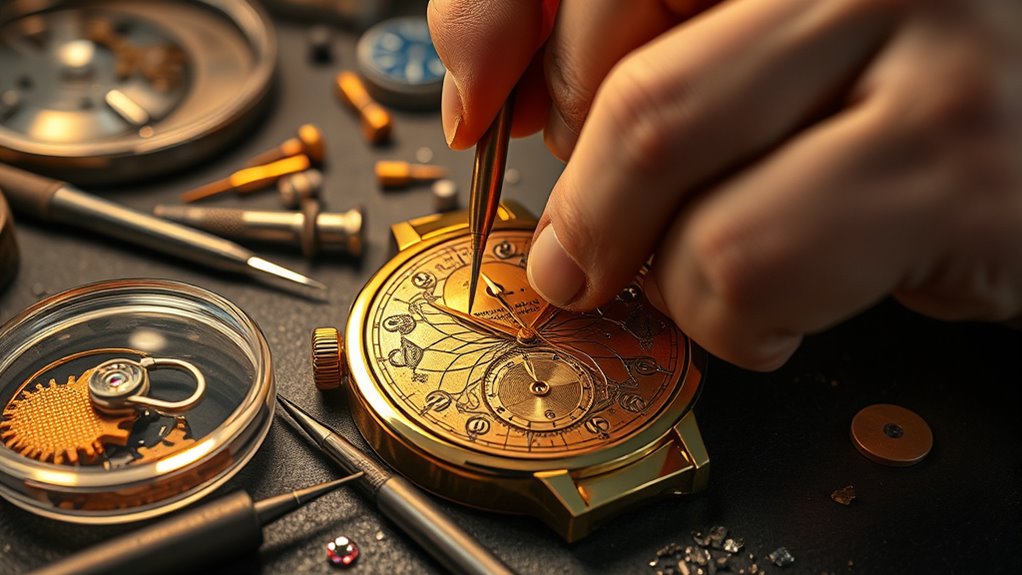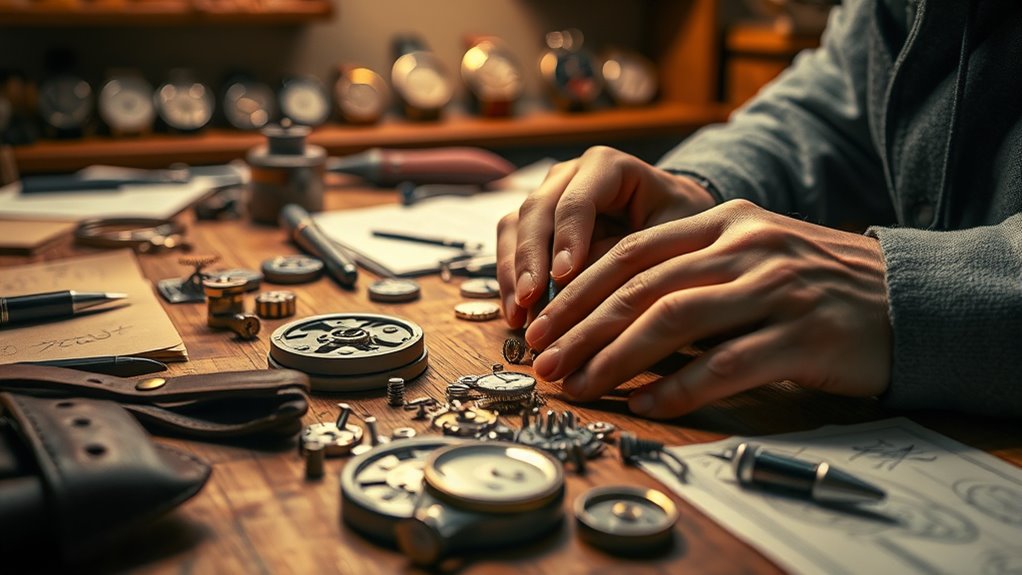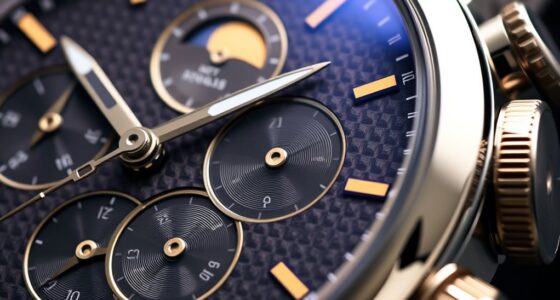Behind the scenes of watchmaking, skilled artisans blend centuries-old techniques with modern technology to craft precise, beautiful timepieces. They carefully select materials like stainless steel, gold, or ceramics, while using advanced tools to shape, polish, and assemble tiny components. Artisans pay close attention to details like engraving and finishing, ensuring each watch reflects craftsmanship and artistry. If you keep exploring, you’ll discover how this intricate process preserves an inspiring heritage of innovation and tradition.
Key Takeaways
- Watchmaking combines centuries-old craftsmanship with modern technology like CNC machining and laser engraving.
- Materials such as gold, titanium, and ceramics are carefully selected and precisely shaped by artisans.
- High-precision assembly of tiny components requires meticulous skills and advanced calibration techniques.
- Artisans use traditional techniques like hand-finishing, engraving, and polishing to enhance aesthetic and cultural value.
- Crafting durable, luxurious cases involves precise fitting, surface finishing, and protection methods to preserve heritage.
The Evolution of Watchmaking Craftsmanship

The evolution of watchmaking craftsmanship reflects a seamless blend of tradition and innovation. In the Art of Watchmaking, you see how techniques that go back centuries now incorporate modern machinery and precision engineering. Watchmaking has shifted from manual, clockmaker methods to include advanced tools like Swiss-style lathes and CNC machines, which improve accuracy and complexity. The progression from purely mechanical movements to quartz technology in the 20th century challenged traditional craftsmanship but also pushed it forward. Today, contemporary watchmakers preserve artisanal skills while integrating new materials and techniques. This combination allows for higher precision, innovative designs, and better performance. Additionally, biodiversity in materials and other technical factors are increasingly being considered to enhance the aesthetic and functional quality of timepieces. Ultimately, the evolution of watchmaking showcases how craftsmanship adapts, blending time-honored skills with groundbreaking advancements.
Mastering Movement Design and Assembly

To master movement design and assembly, you need to focus on precision in crafting each component and perfecting your assembly techniques. Every tiny part requires careful handling and exact placement to guarantee the watch functions flawlessly. With practice, you’ll develop the skill to assemble intricate systems that keep time accurately and reliably. Incorporating innovative automation technologies can further streamline the assembly process and improve consistency. Developing a deep understanding of horology can enhance your ability to troubleshoot and refine watch movements. Additionally, understanding and applying famous quotes about fatherhood can inspire patience and dedication during complex tasks. Engaging in hackathons focused on precision engineering and design can also provide valuable hands-on experience and foster innovative problem-solving skills.
Precision in Component Crafting
Master watchmakers dedicate themselves to crafting movement components with extraordinary precision, often working to micrometer tolerances. Watchmaking is a blend of artistry and science, where each tiny gear, spring, and pinion must be created with meticulous care. Behind the Scenes, this process involves high-precision Swiss-style lathes and CNC machines that produce components with remarkable consistency. You carefully design and machine each part to guarantee perfect fit and function, knowing that even the smallest deviation can affect accuracy. The craft also requires delicate hand-fitting and adjustments, fine-tuning the movement for peak performance and durability. This level of precision is crucial for creating reliable, long-lasting watches that maintain their accuracy over time, truly showcasing the mastery behind the art of watchmaking. Myelination plays a key role in ensuring the efficiency of neural communication, similar to how precise component fitting ensures the accuracy of a watch. Additionally, the integration of advanced measurement techniques ensures that each component meets strict quality standards, which is essential in maintaining overall watch accuracy. Furthermore, the use of sophisticated inspection tools allows watchmakers to verify that every part adheres to exact specifications, reinforcing the importance of quality control in the manufacturing process. Proper calibration and testing, which are vital in precision engineering, further guarantee that each watch performs flawlessly over its lifespan.
Assembly Techniques Mastery
Achieving flawless movement assembly requires exceptional skill and attention to detail, as each tiny part must be precisely placed and aligned under magnification. You carefully handle components like gears, springs, and jewel bearings using specialized tools such as tweezers, screwdrivers, and movement holders. Precise hand placement is vital to ensure proper fit and function, often within tolerances measured in microns. The assembly process involves multiple calibration stages, adjusting each component to optimize accuracy and reliability. Advanced machining and finishing techniques are integrated to guarantee seamless fit and aesthetic perfection within the movement. Your meticulous approach guarantees that every gear, spring, and jewel bearing works harmoniously, creating a reliable and beautiful mechanical masterpiece. Incorporating regulatory frameworks ensures that assembly standards meet industry safety and quality requirements, elevating the craftsmanship to an art form. A thorough understanding of reviews and standards plays a crucial role in maintaining consistent quality and safety in watchmaking. Moreover, attention to material properties is essential to ensure durability and performance throughout the watch’s lifespan. Additionally, understanding essential oils for precision work can enhance concentration and steadiness during delicate assembly tasks.
The Art of Case Construction and Material Selection

The choice of materials and construction techniques directly affects your watch’s durability and appearance. Skilled artisans shape and finish metals like stainless steel, gold, platinum, and titanium to create a refined, resilient case. Precision fitting and advanced methods guarantee the case protects the movement while enhancing the watch’s luxury appeal. Incorporating high-quality insulation techniques can also help preserve the internal components from environmental factors, ensuring longer-lasting performance. Additionally, selecting the appropriate case construction methods contributes to the overall robustness and aesthetic of the timepiece. Using innovative manufacturing processes can further improve the precision and integrity of the case, resulting in a superior final product. Employing material selection strategies tailored to specific watch functions can optimize both performance and longevity.
Material Choices and Impact
Choosing the right case material is crucial because it directly affects your watch’s durability, weight, and visual appeal. Materials like stainless steel, gold, or platinum each bring unique qualities: stainless steel offers strength and resistance to corrosion, while gold and platinum add luxury and elegance. Advanced materials like titanium and ceramic are becoming popular for their lightweight feel and scratch resistance, making your watch more comfortable and longer-lasting. The material you select influences the craftsmanship needed; different metals require specialized techniques to shape, polish, and finish, which impacts the watch’s overall artistry and value. Additionally, material properties such as hardness and corrosion resistance play a significant role in how well a watch performs over time. For example, hardness affects how well a watch resists scratches, ensuring it maintains its pristine appearance. Moreover, choosing the right material can also complement the ambiance and style of the watch, enhancing its overall aesthetic and appeal. An understanding of material selection can help you make informed decisions that align with your personal taste and lifestyle. By understanding these choices, you can appreciate how material impacts not just appearance but also your watch’s performance and longevity.
Crafting Techniques and Finishes
Crafting a watch case involves precise techniques that guarantee durability, aesthetic appeal, and proper function. You shape and polish materials like steel, gold, or platinum to form a robust shell that protects the movement. Material choice is critical; luxury watches often use precious metals, ceramics, or high-tech composites for enhanced longevity and beauty. Techniques such as CNC machining ensure exact dimensions, while hand finishing and polishing deliver a flawless surface. You might add engraving, texturing, or polishing to elevate visual appeal and tactile quality. Skilled artisans meticulously assemble and seal the case components, ensuring water resistance, structural integrity, and overall harmony. Every step combines craftsmanship and technology to create a case that’s both functional and stunning, reflecting the artistry behind high-end watchmaking. The selection of materials plays a vital role in achieving both aesthetic and functional excellence in case construction.
The Finishing Touches: Engraving and Polishing Techniques

Engraving and polishing are essential steps that elevate a watch from functional to exceptional. You use intricate hand or machine carving to add personalized or decorative details, showcasing craftsmanship. Skilled artisans employ specialized tools like burrs and abrasive pastes to achieve precise engravings that enhance the watch’s character. Polishing methods such as mirror polishing and brushing create smooth, reflective surfaces, boosting visual appeal. Finishing touches like angling and polishing edges improve the watch’s harmony, making components look seamless while reducing sharpness. The combination of engraving and polishing not only enhances the watch’s beauty but also highlights the meticulous attention to detail behind its creation. These techniques reflect the true artistry involved in transforming a functional timepiece into a masterpiece.
Skilled Artisans Behind the Creation of Luxury Watches

You may not see it, but behind every luxury watch is a team of artisans who dedicate years to perfect their skills. Their mastery comes from relentless practice and attention to detail, ensuring each piece meets the highest standards. It’s their craftsmanship that transforms raw components into timeless works of art.
Mastery Through Dedication
Behind every exquisite luxury watch lies the skill and dedication of master artisans who spend years honing their craft. You, as a watchmaker, undergo rigorous training to master assembling, regulating, and restoring intricate mechanical movements. Your expertise guarantees each component is crafted with precision, often using specialized tools and techniques passed down through generations. Every tiny part you shape and finish must meet tight tolerances to guarantee flawless operation. Your meticulous attention to detail extends from machining small components to applying aesthetic embellishments, ensuring the watch’s durability and timeless beauty. Your dedication directly influences the quality of the final piece, transforming raw materials into a masterpiece. It’s this relentless pursuit of excellence that elevates a luxury watch from a timekeeping device to a work of art.
Unparalleled Craftsmanship Skills
The creation of luxury watches relies on artisans whose craftsmanship combines decades of experience with meticulous attention to detail. You’ll find these skilled professionals undergo years of rigorous training to master intricate assembly, regulation, and finishing techniques. They blend traditional craftsmanship with modern tools like microscopes and precision lathes to craft tiny, complex components. Each piece is carefully hand-finished through polishing, engraving, and decorative texturing, ensuring both beauty and functionality. Their expertise guarantees that every watch movement meets strict tolerances—often within a few microns—delivering flawless performance and durability. Behind every high-end watch is a dedicated team of craftsmen whose artistry transforms technical mastery into wearable works of art. Their unparalleled skills elevate watchmaking into a true form of craftsmanship excellence.
Precision Tools and Machinery in Modern Watchmaking

Modern watchmaking depends heavily on advanced precision tools and machinery to produce tiny, highly accurate components with remarkable consistency. You use Swiss-style lathes and bar feeders to shape and feed raw materials precisely, guaranteeing perfect dimensions. CNC (Computer Numerical Control) machines automate manufacturing, maintaining tight tolerances and uniform quality. Specialized cleaning and inspection machines remove debris and verify parts’ dimensions, vital for flawless movements. High-precision instruments like coordinate measuring machines (CMMs) and laser scanners verify component accuracy during production. This integration of modern machinery allows you to perform complex tasks—shaping, drilling, finishing tiny parts—with minimal human error. These tools guarantee each component meets the strict standards required for precise, reliable timekeeping, elevating craftsmanship through technological innovation.
Customization and Personalization in Haute Horlogerie

Customization and personalization have become defining features of haute horlogerie, allowing you to create a watch that reflects your unique style and preferences. You can choose engraved initials, personalized case backs, or bespoke strap designs that suit your taste. Master watchmakers often work directly with you to craft one-of-a-kind dials, using materials like enamel, gemstones, or rare metals to add distinctive flair. You might also customize movement functions or add specific complications to meet your needs. Some brands offer exclusive monogramming or limited-edition pieces that showcase your personal identity. The process involves detailed consultations, sketches, and multiple craftsmanship stages, ensuring your timepiece is truly bespoke. This level of personalization transforms a watch into a meaningful expression of your individuality.
Maintaining Quality: Servicing and Repairing Timepieces

Maintaining the precision and longevity of a luxury watch requires regular servicing and expert repairs. Typically, you should have your watch serviced every 3 to 5 years to keep it performing at its best. During professional repairs, watchmakers carefully disassemble the movement, clean each part with ultrasonic equipment, and replace worn components as needed. Proper lubrication during this process reduces friction and prevents premature wear, extending your watch’s lifespan. Precise reassembly and regulation ensure the timekeeping remains accurate. After servicing, thorough testing confirms the watch’s accuracy and water resistance. Using specialized tools like timing machines and microscopes, experts fine-tune your timepiece to meet strict standards, preserving its craftsmanship and ensuring it continues to perform flawlessly for years to come.
The Significance of Craftsmanship and Artistic Vision

While regular servicing keeps a watch running smoothly, it’s the craftsmanship and artistic vision behind each timepiece that truly elevate its value. You see, craftsmanship combines technical mastery with artistic creativity, making each watch both precise and visually stunning. Every luxury watch reflects the personal artistic vision of the watchmaker, showcased through intricate finishing techniques like engraving and polishing. These detailed processes require years of specialized training, emphasizing meticulous attention to detail and a commitment to quality. Artistic vision guides designers to create unique features and aesthetic elements, transforming functional parts into works of art. This harmonious blend of craftsmanship and creativity ensures that every watch embodies technical excellence and timeless beauty, making it a true expression of the watchmaker’s skill and vision.
Preserving Heritage: The Legacy of Fine Watchmaking

Preserving the legacy of fine watchmaking relies on honoring centuries-old craftsmanship and passing down time-honored techniques from one generation of master artisans to the next. You’ll see heritage brands preserve traditional methods like hand-finishing, engraving, and precise assembly to keep authenticity and quality alive. Many watchmakers incorporate historical design elements and iconic features to honor their brand’s roots. Preservation efforts also involve restoring vintage timepieces using original materials and techniques, ensuring their historical value endures. The legacy emphasizes meticulous attention to detail, craftsmanship, and a relentless commitment to timeless excellence. By maintaining these practices, you help sustain the artistry that defines fine watchmaking, ensuring that future generations continue to appreciate and uphold this rich tradition.
Frequently Asked Questions
What Is the Art of Watchmaking Called?
You’re asking what the art of watchmaking is called. It’s known as horology, a blend of science, art, and craftsmanship. When it involves high-end, handcrafted pieces, it’s called haute horlogerie. This process combines intricate mechanical movements with artistic finishing, emphasizing precision and creativity. Whether mass-produced or bespoke, watchmaking requires skill, patience, and passion, making it a true art form that captures time and craftsmanship beautifully.
Can You Self Teach Watchmaking?
Sure, you can teach yourself watchmaking—if you enjoy a challenge that involves tiny gears, endless patience, and a mountain of specialized tools. Start with basic repair kits, practice on inexpensive movements, and study detailed diagrams. Expect frustration, but also small victories. With dedication, you’ll develop fine motor skills and technical knowledge, turning that watch repair hobby into a true craft. Just remember, patience and persistence are your best friends.
Who Are the Big 3 in Watchmaking?
You’re asking about the “Big 3” in watchmaking, which are Rolex, Patek Philippe, and Audemars Piguet. These brands stand out for their exceptional craftsmanship, innovation, and heritage. Rolex is famous for durability and iconic designs, Patek Philippe for complex complications, and Audemars Piguet for pioneering luxury sports watches like the Royal Oak. Together, they set the highest standards for quality, exclusivity, and craftsmanship in the industry.
What Is the Daniels Method of Watchmaking?
You ask about the Daniels Method of watchmaking. It’s a traditional, meticulous process where each component is handcrafted with precision. Unlike mass production, it combines artistry with technical skill, emphasizing hand-finishing, engraving, and polishing. You focus on using high-quality materials to craft durable, beautiful watches. This method highlights craftsmanship and dedication, creating timepieces that are not only functional but also works of art, showcasing the master’s skill at every step.
Conclusion
As you explore deeper into the world of watchmaking, you’ll realize it’s more than just intricate gears and polished cases—it’s a passion that’s been passed down through generations. Behind every masterpiece lies a story waiting to be uncovered, a secret craft that could change your perception forever. So, when you admire a luxury watch, remember, the true artistry might just be hidden in the shadows, waiting for you to discover it.










